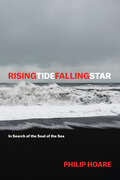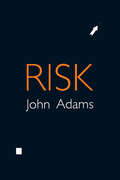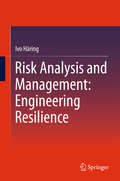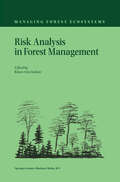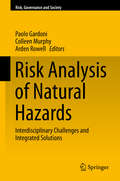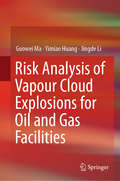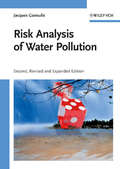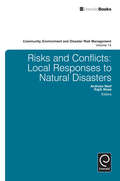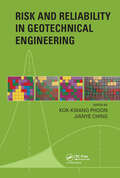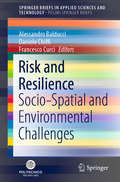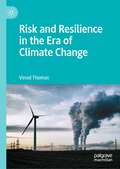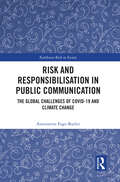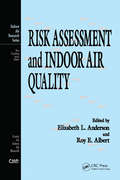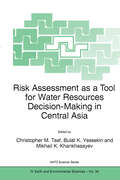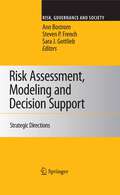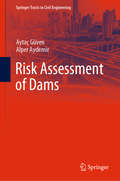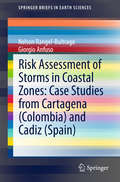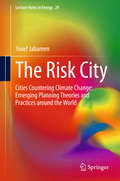- Table View
- List View
RISINGTIDEFALLINGSTAR: In Search of the Soul of the Sea
by Philip Hoare“Every day is an anxiety in my ways of getting to the water. . . . I’ve become so attuned to it, so scared of it, so in love with it that sometimes I can only think by the sea. It is the only place I feel at home.” Many of us visit the sea. Admire it. Even profess to love it. But very few of us live it. Philip Hoare does. He swims in the sea every day, either off the coast of his native Southampton or his adopted Cape Cod. He watches its daily and seasonal changes. He collects and communes with the wrack—both dead and never living—that it throws up on the shingle. He thinks with, at, through the sea. All of which should prepare readers: RISINGTIDEFALLINGSTAR is no ordinary book. It mounts no straight-ahead argument. It hews to no single genre. Instead, like the sea itself, it moves, flows, absorbs, transforms. In its pages we find passages of beautiful nature and travel writing, lyrical memoir, seams of American and English history and much more. We find Thoreau and Melville, Bowie and Byron, John Waters and Virginia Woolf, all linked through a certain refusal to be contained, to be strictly defined—an openness to discovery and change. Running throughout is an air of elegy, a reminder that the sea is an ending, a repository of lost ships, lost people, lost ways of being. It is where we came from; for Hoare, it is where he is going. “Every swim is a little death,” Hoare writes, “but it is also a reminder that you are alive.” Few books have ever made that knife’s edge so palpable. Read RISINGTIDEFALLINGSTAR. Let it settle into the seabed of your soul. You’ll never forget it.
RISINGTIDEFALLINGSTAR: In Search of the Soul of the Sea
by Philip Hoare“Every day is an anxiety in my ways of getting to the water. . . . I’ve become so attuned to it, so scared of it, so in love with it that sometimes I can only think by the sea. It is the only place I feel at home.” Many of us visit the sea. Admire it. Even profess to love it. But very few of us live it. Philip Hoare does. He swims in the sea every day, either off the coast of his native Southampton or his adopted Cape Cod. He watches its daily and seasonal changes. He collects and communes with the wrack—both dead and never living—that it throws up on the shingle. He thinks with, at, through the sea. All of which should prepare readers: RISINGTIDEFALLINGSTAR is no ordinary book. It mounts no straight-ahead argument. It hews to no single genre. Instead, like the sea itself, it moves, flows, absorbs, transforms. In its pages we find passages of beautiful nature and travel writing, lyrical memoir, seams of American and English history and much more. We find Thoreau and Melville, Bowie and Byron, John Waters and Virginia Woolf, all linked through a certain refusal to be contained, to be strictly defined—an openness to discovery and change. Running throughout is an air of elegy, a reminder that the sea is an ending, a repository of lost ships, lost people, lost ways of being. It is where we came from; for Hoare, it is where he is going. “Every swim is a little death,” Hoare writes, “but it is also a reminder that you are alive.” Few books have ever made that knife’s edge so palpable. Read RISINGTIDEFALLINGSTAR. Let it settle into the seabed of your soul. You’ll never forget it.
RISINGTIDEFALLINGSTAR: In Search of the Soul of the Sea
by Philip Hoare“Every day is an anxiety in my ways of getting to the water. . . . I’ve become so attuned to it, so scared of it, so in love with it that sometimes I can only think by the sea. It is the only place I feel at home.” Many of us visit the sea. Admire it. Even profess to love it. But very few of us live it. Philip Hoare does. He swims in the sea every day, either off the coast of his native Southampton or his adopted Cape Cod. He watches its daily and seasonal changes. He collects and communes with the wrack—both dead and never living—that it throws up on the shingle. He thinks with, at, through the sea. All of which should prepare readers: RISINGTIDEFALLINGSTAR is no ordinary book. It mounts no straight-ahead argument. It hews to no single genre. Instead, like the sea itself, it moves, flows, absorbs, transforms. In its pages we find passages of beautiful nature and travel writing, lyrical memoir, seams of American and English history and much more. We find Thoreau and Melville, Bowie and Byron, John Waters and Virginia Woolf, all linked through a certain refusal to be contained, to be strictly defined—an openness to discovery and change. Running throughout is an air of elegy, a reminder that the sea is an ending, a repository of lost ships, lost people, lost ways of being. It is where we came from; for Hoare, it is where he is going. “Every swim is a little death,” Hoare writes, “but it is also a reminder that you are alive.” Few books have ever made that knife’s edge so palpable. Read RISINGTIDEFALLINGSTAR. Let it settle into the seabed of your soul. You’ll never forget it.
RISINGTIDEFALLINGSTAR: In Search of the Soul of the Sea
by Philip Hoare“Every day is an anxiety in my ways of getting to the water. . . . I’ve become so attuned to it, so scared of it, so in love with it that sometimes I can only think by the sea. It is the only place I feel at home.” Many of us visit the sea. Admire it. Even profess to love it. But very few of us live it. Philip Hoare does. He swims in the sea every day, either off the coast of his native Southampton or his adopted Cape Cod. He watches its daily and seasonal changes. He collects and communes with the wrack—both dead and never living—that it throws up on the shingle. He thinks with, at, through the sea. All of which should prepare readers: RISINGTIDEFALLINGSTAR is no ordinary book. It mounts no straight-ahead argument. It hews to no single genre. Instead, like the sea itself, it moves, flows, absorbs, transforms. In its pages we find passages of beautiful nature and travel writing, lyrical memoir, seams of American and English history and much more. We find Thoreau and Melville, Bowie and Byron, John Waters and Virginia Woolf, all linked through a certain refusal to be contained, to be strictly defined—an openness to discovery and change. Running throughout is an air of elegy, a reminder that the sea is an ending, a repository of lost ships, lost people, lost ways of being. It is where we came from; for Hoare, it is where he is going. “Every swim is a little death,” Hoare writes, “but it is also a reminder that you are alive.” Few books have ever made that knife’s edge so palpable. Read RISINGTIDEFALLINGSTAR. Let it settle into the seabed of your soul. You’ll never forget it.
RISINGTIDEFALLINGSTAR: In Search of the Soul of the Sea
by Philip Hoare“Every day is an anxiety in my ways of getting to the water. . . . I’ve become so attuned to it, so scared of it, so in love with it that sometimes I can only think by the sea. It is the only place I feel at home.” Many of us visit the sea. Admire it. Even profess to love it. But very few of us live it. Philip Hoare does. He swims in the sea every day, either off the coast of his native Southampton or his adopted Cape Cod. He watches its daily and seasonal changes. He collects and communes with the wrack—both dead and never living—that it throws up on the shingle. He thinks with, at, through the sea. All of which should prepare readers: RISINGTIDEFALLINGSTAR is no ordinary book. It mounts no straight-ahead argument. It hews to no single genre. Instead, like the sea itself, it moves, flows, absorbs, transforms. In its pages we find passages of beautiful nature and travel writing, lyrical memoir, seams of American and English history and much more. We find Thoreau and Melville, Bowie and Byron, John Waters and Virginia Woolf, all linked through a certain refusal to be contained, to be strictly defined—an openness to discovery and change. Running throughout is an air of elegy, a reminder that the sea is an ending, a repository of lost ships, lost people, lost ways of being. It is where we came from; for Hoare, it is where he is going. “Every swim is a little death,” Hoare writes, “but it is also a reminder that you are alive.” Few books have ever made that knife’s edge so palpable. Read RISINGTIDEFALLINGSTAR. Let it settle into the seabed of your soul. You’ll never forget it.
Risk: Living With Perils In The 21st Century (Advances In Natural And Technological Hazards Research Ser. #33)
by John AdamsRisk compensation postulates that everyone has a "risk thermostat" and that safety measures that do not affect the setting of the thermostat will be circumvented by behaviour that re-establishes the level of risk with which people were originally comfortable. It explains why, for example, motorists drive faster after a bend in the road is straightened. Cultural theory explains risk-taking behaviour by the operation of cultural filters. It postulates that behaviour is governed by the probable costs and benefits of alternative courses of action which are perceived through filters formed from all the previous incidents and associations in the risk-taker's life.; "Risk" should be of interest to many readers throughout the social sciences and in the world of industry, business, engineering, finance and public administration, since it deals with a fundamental part of human behaviour that has enormous financial and economic implications.
Risk
by John AdamsRisk compensation postulates that everyone has a "risk thermostat" and that safety measures that do not affect the setting of the thermostat will be circumvented by behaviour that re-establishes the level of risk with which people were originally comfortable. It explains why, for example, motorists drive faster after a bend in the road is straightened. Cultural theory explains risk-taking behaviour by the operation of cultural filters. It postulates that behaviour is governed by the probable costs and benefits of alternative courses of action which are perceived through filters formed from all the previous incidents and associations in the risk-taker's life.; "Risk" should be of interest to many readers throughout the social sciences and in the world of industry, business, engineering, finance and public administration, since it deals with a fundamental part of human behaviour that has enormous financial and economic implications.
Risk Analysis and Management: Engineering Resiliency
by Ivo HäringThe book introduces basic risk concepts and then goes on to discuss risk management and analysis processes and steps. The main emphasis is on methods that fulfill the requirements of one or several risk management steps. The focus is on risk analysis methods including statistical-empirical analyses, probabilistic and parametrized models, engineering approaches and simulative methods, e.g. for fragment and blast propagation or hazard density computation.Risk management is essential for improving all resilience management steps: preparation, prevention, protection, response and recovery. The methods investigate types of event and scenario, as well as frequency, exposure, avoidance, hazard propagation, damage and risks of events. Further methods are presented for context assessment, risk visualization, communication, comparison and assessment as well as selecting mitigation measures. The processes and methods are demonstrated using detailed results and overviews of security research projects, in particular in the applications domains transport, aviation, airport security, explosive threats and urban security and safety. Topics include: sufficient control of emerging and novel hazards and risks, occupational safety, identification of minimum (functional) safety requirements, engineering methods for countering malevolent or terrorist events, security research challenges, interdisciplinary approaches to risk control and management, risk-based change and improvement management, and support of rational decision-making.The book addresses advanced bachelor students, master and doctoral students as well as scientists, researchers and developers in academia, industry, small and medium enterprises working in the emerging field of security and safety engineering.
Risk Analysis in Forest Management (Managing Forest Ecosystems #2)
by Klaus Von GadowDue to the long-term planning horizons and the great variety of natural, economic, and operational hazards affecting forest ecosystems, uncertainty and multiple risk are typical aspects of forest management. Applications of risk analysis are surprisingly rare, in spite of the rich assortment of sophisticated forest planning tools that are available today. The objective of this particular volume within the book series Managing Forest Ecosystems is to present state-of-the-art research results, concepts, and techniques regarding the assessment and evaluation of natural hazards and the analysis of risk and uncertainty relating to forest management. Various aspects of risk analysis are covered, including examples of specific modelling tools. The book is divided into three sections covering ecological perspectives, applications in engineering and planning, and methods applicable to economics and policy.
Risk Analysis of Natural Hazards: Interdisciplinary Challenges and Integrated Solutions (Risk, Governance and Society #19)
by Paolo Gardoni Colleen Murphy Arden RowellThis volume investigates the interdisciplinary and cross-cutting challenges in the risk analysis of natural hazards. It brings together leading minds in engineering, science, philosophy, law, and the social sciences. Parts I and II of this volume explore risk assessment, first by providing an overview of the interdisciplinary interactions involved in the assessment of natural hazards, and then by exploring the particular impacts of climate change on natural hazard assessment. Part III discusses the theoretical frameworks for the evaluation of natural hazards. Finally, Parts IV and V address the risk management of natural hazards, providing first an overview of the interdisciplinary interactions underlying natural hazard management, and then exploring decision frameworks that can help decision makers integrate and respond to the complex relationships among natural events, the built environment, and human behavior.
Risk Analysis of Vapour Cloud Explosions for Oil and Gas Facilities
by Guowei Ma Yimiao Huang Jingde LiThis book focuses on describing and applying risk analysis of vapour cloud explosions (VCEs) in various oil and gas facilities, such as petrol stations, processing plants, and offshore platforms. Discussing most of the complicated features of gas explosion accidents, the book studies in detail the gas explosion risk analysis approaches of different oil and gas facilities in order to develop more accurate, detailed, efficient and reliable risk analysis methods for VCEs under different conditions. Moreover, it introduces an advanced overpressure approach to predict VCEs using computational fluid dynamics (CFD) modelling, and details applications of CFD using a FLame ACceleration Simulator (FLACS). The book is intended for researchers and organisations engaged in risk and safety assessments of VCEs in the oil and gas industry.
Risk Analysis of Water Pollution
by Jacques GanoulisThis new edition of a classic text has now been extensively updated to include the latest developments in risk analysis and water quality assessment and management. It takes into account the role of ecological water quality in integrated regional and transboundary water resources management, according to the latest UNESCO programmes and the new EU-Water Framework Directive. This practice-oriented textbook is a unique tool for identifying and evaluating local and regional environmental risks from pollution hazards in groundwater, river water and coastal seawaters. The book explains different risk-based probabilistic methodologies and fuzzy logic-based approaches and includes various mathematical models for water quality simulation and theories, such as the decision analysis, the utility theory and the integrated risk-based multi-criteria assessment and management, in order to thoroughly evaluate several case studies from the real world. Questions testing the reader?s understanding are given at the end of each chapter, and a useful appendix provides hints for answering them as well the solutions themselves.
Risk and Conflicts: Local Responses to Natural Disasters (Community, Environment and Disaster Risk Management #14)
by Andreas Neef Rajib ShawCommunities affected by natural disasters are often stigmatized as being passive with regard to disaster prevention, mitigation and adaptation, waiting only for government assistance in the aftermath of such events. However, many innovative community initiatives have been developed to address natural disasters, which are often characterized as "local responses". While scrutinizing the potential strength and comparative advantage of community-based disaster response, this book analyzes and illustrates how individuals, families and social groups in rural and urban communities perceive natural disasters, their underlying reasons and their effects on their livelihoods, and documents and analyzes the role of local responses to natural disasters and conflict. Key factors determining the degree of vulnerability and resilience of affected communities are also elicited. Several pivotal issues related to community-based disaster responses are addressed, such as the relationship between local and external knowledge in addressing disasters, the relevance of institutional and policy frameworks for community-based disaster response and the role of social capital and collective action.
Risk and Reliability in Geotechnical Engineering
by Kok-Kwang Phoon Jianye ChingEstablishes Geotechnical Reliability as Fundamentally Distinct from Structural Reliability Reliability-based design is relatively well established in structural design. Its use is less mature in geotechnical design, but there is a steady progression towards reliability-based design as seen in the inclusion of a new Annex D on "Reliability of Geotechnical Structures" in the third edition of ISO 2394. Reliability-based design can be viewed as a simplified form of risk-based design where different consequences of failure are implicitly covered by the adoption of different target reliability indices. Explicit risk management methodologies are required for large geotechnical systems where soil and loading conditions are too varied to be conveniently slotted into a few reliability classes (typically three) and an associated simple discrete tier of target reliability indices. Provides Realistic Practical Guidance Risk and Reliability in Geotechnical Engineering makes these reliability and risk methodologies more accessible to practitioners and researchers by presenting soil statistics which are necessary inputs, by explaining how calculations can be carried out using simple tools, and by presenting illustrative or actual examples showcasing the benefits and limitations of these methodologies. With contributions from a broad international group of authors, this text: Presents probabilistic models suited for soil parameters Provides easy-to-use Excel-based methods for reliability analysis Connects reliability analysis to design codes (including LRFD and Eurocode 7) Maximizes value of information using Bayesian updating Contains efficient reliability analysis methods Accessible To a Wide Audience Risk and Reliability in Geotechnical Engineering presents all the "need-to-know" information for a non-specialist to calculate and interpret the reliability index and risk of geotechnical structures in a realistic and robust way. It suits engineers, researchers, and students who are interested in the practical outcomes of reliability and risk analyses without going into the intricacies of the underlying mathematical theories.
Risk and Resilience: Socio-Spatial and Environmental Challenges (SpringerBriefs in Applied Sciences and Technology)
by Alessandro Balducci Daniele Chiffi Francesco CurciThis book presents and discusses methodological approaches and operational tools aimed at increasing the awareness and skills necessary to face the social, economic and environmental challenges usually encountered in spatial planning. In addition, it deals with the concepts of risk and resilience from both a theoretical and operational point of view. The book promotes a better understanding of risk, resilience, and related notions such as vulnerability, fragility and anti-fragility in urban and landscape studies, while also analyzing new planning policies. Accordingly, it will benefit all researchers and public decision-makers looking for an interdisciplinary approach to risk and resilience.
Risk and Resilience in the Era of Climate Change
by Vinod ThomasThis book presents essential insights on the interaction between rising risks and raising the bar for resilience during the climate crisis. Its timeliness lies in applying important findings on risk and resilience to runaway climate change. When risk and resilience are brought together in the context of climate catastrophes, three key messages emerge.The first is that accounting for the root causes of these calamities, and not just their symptoms, is essential to slowing the spike in these events. It is therefore vital to link carbon emissions from human activity to the sharp rise in climate disasters globally. The second is that growth economics and policy must factor in the failure of governments and businesses to tackle spillover harm from economic activities, as seen dramatically with global warming. With climate risks rising, this calls for a fundamental revision in the teaching and practice of business and economics. And third, prevention must become a far bigger part of resilience building, with greater preparedness for more intense destruction built into interventions. This emphasis on prevention deems disaster recovery as not just returning to how things were but building back better.
Risk and Responsibilisation in Public Communication: The Global Challenges of COVID-19 and Climate Change (Earthscan Risk in Society)
by Antoinette Fage-ButlerThis book explores the connections between risk and responsibilisation in official communication to the public about the global risks of the pandemic and climate change. Our media spheres in the 2020s have been saturated with information about what we should or should not be doing to meet the challenges of the COVID-19 pandemic and climate change. Although the ability of risk communication to ‘responsibilise’ the public is central to its functioning in our societies, this aspect has so far been under-investigated in academia. To address this lacuna, Antoinette Fage-Butler develops a discursive approach to risk communication that focuses on the values that are communicated in risk messages. Examples of official risk communication about the pandemic and climate change from national and transnational contexts are analysed and compared, leading to new empirical findings and theoretical insights about the nature of risk and responsibilisation. Fage-Butler also builds on recent stirrings in the evolving field of risk communication that highlight the importance of cultural and value-related factors. Overall, this book will equip researchers with an approach to risk communication that reflects the complexity of today’s global risk challenges. Risk and Responsibilisation in Public Communication will be of great interest to students and scholars of risk communication, public health and environmental studies.
Risk and Responsibilisation in Public Communication: The Global Challenges of COVID-19 and Climate Change (Earthscan Risk in Society)
by Antoinette Fage-ButlerThis book explores the connections between risk and responsibilisation in official communication to the public about the global risks of the pandemic and climate change. Our media spheres in the 2020s have been saturated with information about what we should or should not be doing to meet the challenges of the COVID-19 pandemic and climate change. Although the ability of risk communication to ‘responsibilise’ the public is central to its functioning in our societies, this aspect has so far been under-investigated in academia. To address this lacuna, Antoinette Fage-Butler develops a discursive approach to risk communication that focuses on the values that are communicated in risk messages. Examples of official risk communication about the pandemic and climate change from national and transnational contexts are analysed and compared, leading to new empirical findings and theoretical insights about the nature of risk and responsibilisation. Fage-Butler also builds on recent stirrings in the evolving field of risk communication that highlight the importance of cultural and value-related factors. Overall, this book will equip researchers with an approach to risk communication that reflects the complexity of today’s global risk challenges. Risk and Responsibilisation in Public Communication will be of great interest to students and scholars of risk communication, public health and environmental studies.
Risk Assessment and Indoor Air Quality (Indoor Air Research)
by Elizabeth L. AndersonWith the recent tightening of air quality standards as mandated by the U.S. EPA, has come great pressure on regulatory bodies at all levels of government, along with the industries and groups affected by these standards, to better assess the hazards and risks that result from air pollutants. Risk Assessment and Indoor Air Quality carefully ties tog
Risk Assessment and Indoor Air Quality (Indoor Air Research)
by Elizabeth L. AndersonWith the recent tightening of air quality standards as mandated by the U.S. EPA, has come great pressure on regulatory bodies at all levels of government, along with the industries and groups affected by these standards, to better assess the hazards and risks that result from air pollutants. Risk Assessment and Indoor Air Quality carefully ties tog
Risk Assessment as a Tool for Water Resources Decision-Making in Central Asia: Proceedings of the NATO Advanced Research Workshop on Risk Assessment as a Tool for Water Resources Decision-Making in Central Asia Almaty, Kazakhstan 23–25 September 2002 (NATO Science Series: IV: #34)
by Mikhail K. Khankhasayev Bulat K. Yessekin Christopher M. TeafWater resources, both in terms of water quality and water quantity, are of critical importance in planning for sustainable development in Central Asia and the Caucasus, as well as in other parts of the world. This NATO Advanced Research Workshop (ARW), entitled "Risk Assessment as a Tool for Water Resources Decision-Making in Central Asia", was conducted on September 23-25, 2002 in Almaty, Kazakhstan. The ARW addressed methods and approaches by which risk assessment methodology that has been developed in the United States, Europe and elsewhere can be applied to environmental and water resource problems in Central Asia. The stated goals of the ARWwere: • to assess the existing state of knowledge in the context of potential applications of risk assessment tools to water resources and other environmental issues in Central Asia; • to identify research gaps and directions for future research in the area of water resources which may be addressed through the application of risk assessment tools; • to promote closer working relationships between the scientists and technical experts from Central Asia and the Caucasus, as well as the scientists and technical experts from the United States and Europe. Based on historical experiences of Central Asian scientists and their colleagues in other parts of the world, there is a demonstrated need in the region to provide education, training and technical assistance on environmental decision-making tools, including risk assessment.
Risk Assessment, Modeling and Decision Support: Strategic Directions (Risk, Governance and Society #14)
by Ann Bostrom Steven P. French Sara J. GottliebThe papers in this volume integrate results from current research efforts in earthquake engineering with research from the larger risk assessment community. The authors include risk and hazard researchers from the major U.S. hazard and earthquake centers. The volume lays out a road map for future developments in risk modeling and decision support, and positions earthquake engineering research within the family of risk analysis tools and techniques.
Risk Assessment of Dams (Springer Tracts in Civil Engineering)
by Aytaç Güven Alper AydemirThis book offers a timely report on methods for risk assessment procedures for dams, with a special emphasis on dams with small storage dimensions. It starts by introducing all important definitions relating to dams, dam safety, such as the most common failure modes, and risks. In turn, it describes in detail the most important evaluation procedures for various failure modes such as piping, flood, earthquake and stability are described in this chapter. Consequence assessment procedures, together with the different steps of the risk evaluation process, are analyzed, providing a guide on how to identify the appropriate failure mode for the examined dam and setting up the appropriate safety plan. The book introduces the most common methods for predicting peak breach discharge, analyzing some relevant case studies. Upon comparing the findings obtained with the different methods, the book concludes with some general suggestions and ideas for future developments. This book fills an important gap between theoretical works and real-life problems being investigating in practical research studies on dam safety and risk management. It provides readers with the necessary knowledge on risk analysis and shows how to apply this in practice to carry out dam safety studies. It offers practical guidelines to set up risk assessment procedures for different failure modes and predicting failure parameters such as failure time, peak breach discharge and breach width.
Risk Assessment of Storms in Coastal Zones: Case Studies From Cartagena (colombia) And Cadiz (spain) (SpringerBriefs in Earth Sciences)
by Nelson Rangel-Buitrago Giorgio AnfusoThis book assists the reader in determining storm risks, focussing on sandy coasts and cliff coasts in the context of expected sea level rise from littoral transformation and climate change. It examines storm impacts through matrixes concerning physical parameters, socio-economic activities, ecological and historic resources, and it presents the Coastline Risk to Storms Index as a single numerical measure of the risk for a given area.The methodology is described and tested against two coastal areas: one in the Caribbean Sea (Cartagena, Colombia) and the other on the coast of the Atlantic Ocean (Cadiz, Spain). Both areas record an important flow of tourists associated with the “sun, sea and sand market” which represents an economic recourse for the hinterland too.Chapters describe this approach and explore three particular types of variables: i) the forcing variables contributing to storm-induced erosion, ii) dynamic variables that determine the resilience to erosion (Susceptibility) and iii) the vulnerable targets grouped in three different contexts (socio-economic, ecological and heritage). These are combined into two separate indices, the Hazard Index (combining forcing and susceptibility) and the Vulnerability Index, which together constitute the Coastline Risk to Storms Index.Maps created using this semi-quantitative approximation method can help to determine the causes, processes and consequences of storm-related processes. This book is therefore important to anyone considering coastal development programs, especially decision-makers: the work presented here can assist in the development of preventative management strategies for the most vulnerable areas.
The Risk City: Cities Countering Climate Change: Emerging Planning Theories and Practices around the World (Lecture Notes in Energy #29)
by Yosef JabareenContemporary cities face phenomenal risks, and they face particularly high levels of mounting social and environmental risks, including social polarization, urban conflicts, riots, terror, and climate change threats. This book suggests that climate change and its resulting uncertainties challenge the concepts, procedures, and scope of conventional approaches to planning, creating a need to rethink and revise current planning methods. Therefore, this book suggests a paradigm shift in our thinking, interrogation, and planning of our cities. Based on the contemporary conditions of risk at cities, this book conceptualizes the risk city as a construct of three interlinked concepts of risk, trust, and practice. It is a construct of risk and its new evolving conditions and knowledge of uncertainties stem from climate change and other risks and uncertainties. As a construct of practices, the risk city produces social and political institutional framework and promotes practices accordingly in order to reduce risk and risk possibilities and to increase trust. In light of the complex challenges and risks to the human habitat that have emerged in recent years, many cities have prepared various types of plans aimed at addressing the challenges posed by climate change. Nonetheless, despite the importance of these plans and the major public resources invested in their formulation, we still know little about them and have yet to begin studying them and assessing their contributions. From the innovative perspective of the risk city, this book asks critical questions about the nature, vision, practices, and potential impact of the recent climate change-oriented plans. What kinds of risks do they attempt to address, what types of practices do they institute, and what types of approaches do they apply? Do they adequately address the risks and uncertainties posed? How do they contribute to the worldwide effort to reduce greenhouse gas emissions? This book uses the methodologically innovative Risk City framework to examine the nature, vision, outcomes, practices, and impact of these crucial plans, as well as their contribution to the resilience of our cities and to global efforts toward reducing greenhouse gas emissions.
